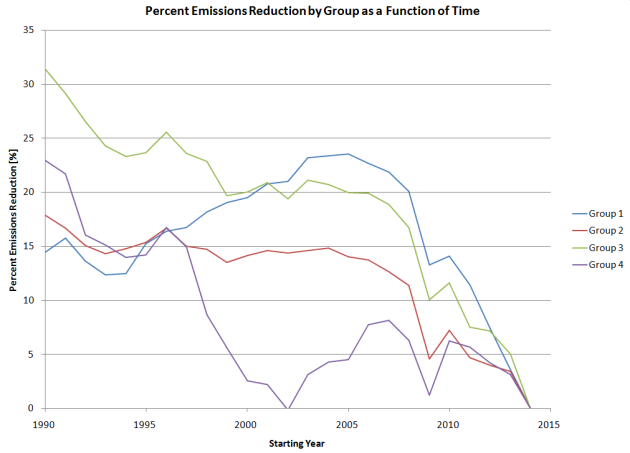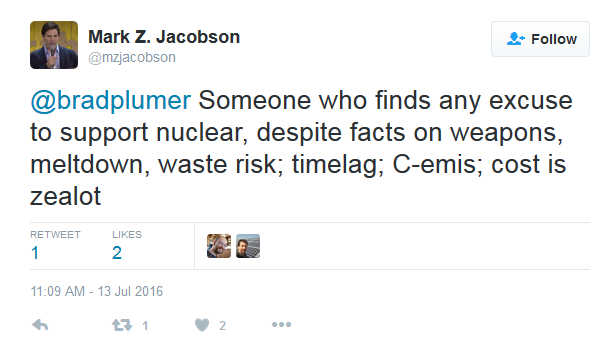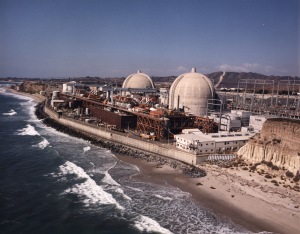Introduction
A few months ago I read a paper, “Nuclear energy and path dependence in Europe’s ‘Energy union’: coherence or continued divergence?” and after reading it, I wasn’t sold. Their fundamental idea was that in countries which are looking to build nuclear or replace existing nuclear, emissions are not dropping as fast as emissions in countries which don’t have nuclear or are closing nuclear facilities, and that the changes in emissions were due to “path dependence”, meaning that once a country decides to go nuclear, they get stuck on that path.
The reason I wasn’t sold was there were a lot of words (21 pages), and three pages of references, but only one table that had any real data. That table showed a number of EU countries, how much their emissions had changed from 2005 and 2012, and the share of renewables in 2013 for that country. The change in emissions was presented in terms of percent reduction, without any data on absolute reduction in emissions, or the starting emissions for that country, and the growth of renewable generation also was not presented.
The data was also compared to 2005, which seemed odd considering the paper talked at length about the EU 2020 Strategy (which started in 2010, and uses 1990 as its baseline). It was also strange that in 2016, data from 2012 was being used instead of data from a more recent year.
So I emailed Dr. Sovacool and Dr. Lawrence (two of the authors) the following questions:
1) What time period was used for the emissions reductions? It seems to be 2005-2012, based on the 2015 EU Commission document page 30, but it’s not clear from the paper.
2) Why was 2005 used as the start of the period? The EU 2020 goes from 2010-2020, and the Lisbon Strategy went from 2000-2010.
3) Why are percentages of emissions reductions from countries with vastly different overall emissions averaged? Eg. France is a large energy producer and had significant cuts in emissions, Romania is relatively small in comparison, but both are weighted equally in the average of % emissions change. Why weren’t the total emissions changes for each group added up and then the percentage taken of that? This seems like a more accurate assessment of whether emissions increased or decreased in those groups of countries.
4) Likewise, why were percentages of renewables share averaged? Again, a small country (by energy consumption/population) with a large renewables share (eg. Iceland) has equal weight in this method to much larger country (eg. Italy).
5) Also, shouldn’t this column look at growth in renewables share over the same time period, not overall percentage? There are many European countries who’ve undergone a huge growth in renewable capacity, and a number that already had a large renewables capacity (eg. hydro) before this time period; if the goal is to identify the impacts of the EU 2020 Strategy, then the change in renewables generation would seem to be more valuable information, no?
I did get a response back from Dr. Sovacool, who said that Dr. Lawrence was on vacation, but he’d respond when he got back. And so I waited, and started to forget about the paper. I figure he probably lost track of my email, it happens.
But recently “The Sussex Energy Group” (Dr. Lawrence, Dr. Stirling, and Dr. Sovacool) has responded to a few other criticisms of this paper, and I read one of the responses. In it, they looked back at their data and realized that some of their numbers in the table from their paper were wrong, and they posted corrected numbers. At this point, I decided to do my own analysis, and here it is.
Analysis of Lawrence, Sovacool, & Stirling
Nicholas Thompson
There is a lot to unpack here, so I’ll try to go step by step.
Problem 1: The math is incorrect
Here The Sussex Group states that emissions reduction data was taken from the Statistical Handbook of the European Union, here is a link directly to that data. This data is presented in proportion to 1990 emissions, where 1990 = 100. What The Sussex Group seems to have done is subtracted the 2012 emissions from the 2005 emissions to get a “percent reduction in emissions”. This is incorrect math. To calculate a percent change of anything, you take (New-Original) *100/Original. By not doing this (dividing by the original value), they didn’t calculate percent change in emissions with a 2005 baseline (as the paper states).
To demonstrate, here is the data for two countries:
Table 1: Relative GHG Emissions Data for Spain and Hungary
|
1990 |
1995 |
2000 |
2005 |
2010 |
2011 |
2012 |
Subtracting 2012-2005 |
Actual Percent Emissions Reduction [%] |
| Spain |
100 |
110.9 |
134.8 |
154.2 |
125.4 |
126.4 |
122.5 |
31.7 |
20.56 |
| Hungary |
100 |
81.3 |
79.5 |
80.6 |
69 |
67.2 |
63.7 |
16.9 |
20.97 |
Doing all this math correctly creates a different table than the one found here:
Table 2: Sussex Data vs. Calculated Percentage Reductions in Emissions
|
Sussex Data |
Corrected Percentage Reduction in Emissions |
| Group 1 Average |
11.80 |
9.67 |
| Austria |
16.00 |
13.33 |
| Cyprus |
1.90 |
1.27 |
| Denmark |
17.50 |
18.54 |
| Estonia |
-1.60 |
-3.49 |
| Greece |
22.60 |
17.61 |
| Ireland |
20.80 |
16.28 |
| Italy |
21.90 |
19.62 |
| Latvia |
-0.40 |
-0.94 |
| Luxembourg |
10.80 |
9.97 |
| Malta |
-9.50 |
-6.45 |
| Portugal |
29.80 |
20.59 |
|
|
|
| Group 2 Average |
13.77 |
12.07 |
| Belgium |
17.80 |
17.73 |
| Germany |
4.30 |
5.32 |
| Netherlands |
8.50 |
8.35 |
| Slovenia |
7.60 |
6.90 |
| Spain |
31.70 |
20.56 |
| Sweden |
12.70 |
13.60 |
|
|
|
| Group 3 Average |
10.19 |
12.92 |
| Bulgaria |
2.30 |
3.95 |
| Czech Republic |
7.10 |
9.54 |
| Finland |
9.90 |
10.10 |
| France |
12.10 |
11.91 |
| Hungary |
16.90 |
20.97 |
| Romania |
9.90 |
17.10 |
| Slovakia |
12.20 |
17.28 |
| UK |
11.10 |
12.53 |
|
|
|
| Group 4 Average |
1.50 |
3.32 |
| Lithuania |
3.40 |
7.11 |
| Poland |
-0.40 |
-0.47 |
In The Sussex Group’s analysis, they split countries into four Groups:
Group 1: No Nuclear
Group 2: Decommissioned/Phasing Out Nuclear
Group 3: Plans to Extend/Replace/Add Nuclear
Group 4: Plans to Resume Nuclear
First note on this is even using their incorrect subtraction method, The Sussex Group data for Sweden and Latvia here is incorrect. The second note is that when using their premise and actually calculating the average percentage change in emissions correctly, their entire thesis is incorrect. It shows that countries with no nuclear had lower emissions reductions than countries which were decommissioning nuclear, and the greatest emissions reductions were in countries which were extending/replacing/adding nuclear.
Problem 2: The method is incorrect
So far, for the sake of argument, I’ve been assuming that method their analysis is correct – and it isn’t. Just averaging emissions changes in countries does not tell you much about the emissions changes in that group of countries, because each country has a different amount of emissions, and some of these countries are vastly different. Averaging a percentage change in emissions in Malta and Italy is meaningless – one has over a hundred times more emissions than the other. Taking a simple average weights these two countries the same, as if they are the same size.
Just to give an example, from 2005 to 2014, Italy reduced its emissions 27.2%, and over the same time period, Malta increased its emissions 2.1%. An average of these two would yield a 12.55% “decrease” in emissions – which is completely wrong! In absolute terms, Malta’s emissions increased 0.1 million tons of CO2-eq, and Italy’s emissions decreased by 160 million tons of CO2-eq. The proper way to calculate percent emissions reductions would be by summing the total emissions reductions for both countries over the time period desired, and dividing by the starting emissions of both countries (and multiplying by 100).
Problem 3: There is no justification for their starting year of analysis
Whenever anyone analyzes anything, the baseline they use is extremely important, and can influence the results. To demonstrate that, I’ve calculated and plotted in Figure 1 the actual percent emissions reductions for each of the 4 Groups that The Sussex Group looked at, as a function of the starting year, with 2014 being the end point. So for instance, on the graph, year 1995 is plotting the percentage emissions reductions for that group from 1995 to 2014. Data is from Eurostat here and here.

Figure 1: Percent Emissions Reductions by Group as a Function of Time
Just for a reminder:
Group 1: No Nuclear
Group 2: Decommissioned/Phasing Out Nuclear
Group 3: Plans to Extend/Replace/Add Nuclear
Group 4: Plans to Resume Nuclear
As the graph shows, with a starting year from 1990 to just after 2000, Group 3 had the most emissions reductions. Using a starting year after that, Group 1 had the most emissions reductions, but was closely followed by Group 3. This shows again, that their conclusion is not supported by the data. But that’s not all.
The paper also makes many references to the EU 2020 targets – which aim to decrease emissions 20% lower than 1990 levels. Based on that goal, it’s clear that 2005 should not be the baseline year, 1990 should. Meaning it’s countries in Groups 1 and 2 which have more work to do to decrease emissions, the countries which do not have nuclear or are decommissioning/phasing out nuclear.
Problem 4: Statistical significance
One of the groups shown here (Group 4) has only two countries, meaning there is likely little statistical significance from this group and no conclusions should be drawn from it. Normally samples are only statistically significant if there are 30 or more observations, which when it comes to countries is sometimes impossible. However the conclusions derived from the analysis in the paper don’t seem to address this limitation of this data.
Problem 5: There’s no attempt to account for population
Normally when comparing the carbon emissions of various countries, the total emissions are put in some context by putting them in terms of per capita emissions. I’ve done that here, for each Group (data here). Group per capita emissions data was calculated by summing the total emissions in each Group and dividing by the total population of each Group. As can be seen in the graph, Group 2 has the highest emissions to start with, followed by Group 1, 3, and 4. As time goes on, per capita emissions in Groups 1, 2, and 3 all drop, with emission for Groups 1 and 3 ending up almost exactly the same in 2014.

Figure 2: Per Capita Emissions by Group
Conclusion
The paper states the following,
“Perhaps most germane – and without necessarily implying causality – there appears to be a prima facie pattern among the disaggregated groups of countries presented above: namely, progress in both carbon emissions reduction and in adoption of renewables appears to be inversely related to the strength of continuing nuclear commitments.”
In the “Policy Relevance” section, the authors write that this article,
“…finds that intensities of national commitment to nuclear power tend to be inversely related to degrees of success in achieving EU climate policy goals.”
None of the data seem to support these conclusions, and the entire paper is based on those conclusions. If anything, countries with nuclear energy tend to have started with lower emissions per capita, and achieved more emissions reductions in percentage terms.
This is actually unsurprising when the data is examined. Many of the Group 3 countries are former Soviet states which were able to close older, dirtier power plants, and the two largest Group 3 countries (France and the United Kingdom) both have seen large reductions in emissions since 1990. All of the Group 3 countries but Finland and France have achieved 20% or more reductions in emissions since 1990, and both Finland and France are well positioned to hit these goals by 2020 as they have already reduced emissions ~15%. Compare that to Group 1, where only three out of 11 countries have reduced emissions by 20%, and four have increased emissions since 1990.
It’s very strange that the authors didn’t just go straight to the actual emissions data (per capita or otherwise) which is readily available online, and calculate emissions changes based on that. Instead, by using relative data incorrectly, they came to an incorrect conclusion.
In short, this paper looks more like there was a preformed conclusion, and data was found to fit that conclusion. The math, method used for calculation, and entire premise of the analysis are all wrong. If I have enough time, I’ll write this up more formally as a response in Climate Policy.














